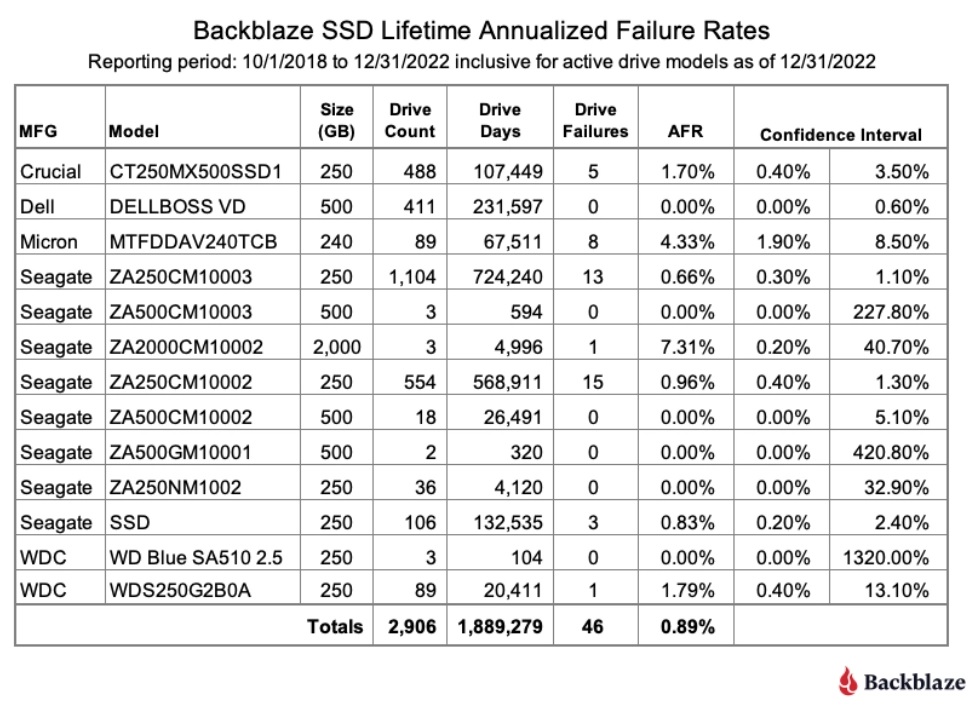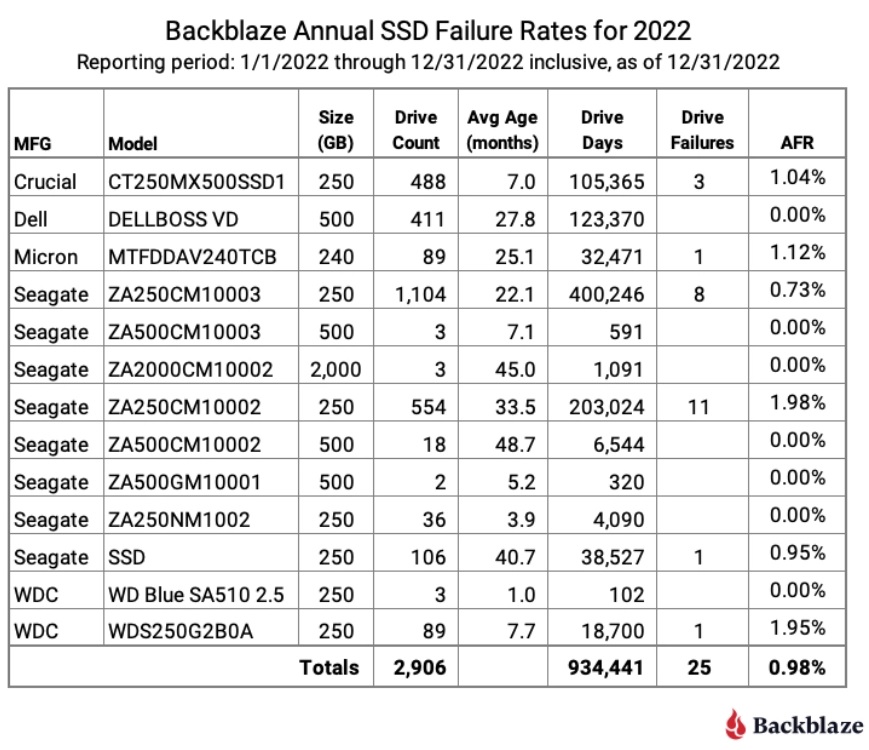Backblaze, a San Mateo, California-based backup and cloud storage firm, on Thursday shared data giving us a unique look at the reliability of SSDs over up to four years of use. Looking at the 2,906 SSDs in its possession, the company tracked the failure rates of mostly consumer-grade SSDs, which it started using as boot drives at the start of Q4 2018.
Backblaze has long shared data on the reliability of hard disk drives (HDDs), but this latest report provides fresh perspective on HDDs' speedier, pricier cousins. As detailed by Backblaze's blog post, the company uses SSDs for booting storage servers, as well as reading, writing, and deleting log and temporary files made by said storage servers. Backblaze said all SSDs analyzed have "similar" workloads.
Before we get into Backblaze's first table, which depicts annualized failure rates (AFRs) for 13 different SSDs models, it's important to note the limited sample size of 2,906 drives and differing number of drives for each model. Some drives have seen way more active use than others, with active days ranging from 104 days up to 724,240. So while these aren't apples-to-apples comparisons of SSD models, the table provides a broad glimpse at SSD reliability that the average person can't replicate on their own.
Backblaze's blog provides several tables depicting SSD failure rates, but this one looks at AFRs across the entire time Backblaze has used SSDs. The company started using SSDs in 2018 but added most of the drives in the table below within the past three years.

The highest AFR (7.31 percent) comes from a 2TB Seagate drive, but that drive also has only been in action for 4,996 days. When looking at drives with at least 100,000 active days, the highest AFR comes from the sole Crucial drive. But, again, all of these drives have different drive counts and days of use.
Backblaze's blog also highlighted the large confidence intervals in the table caused by the limited drive days for those SSDs.
"As we accumulate more data, those confidence intervals should become more accurate," the blog said.
Backblaze said it prefers analyzing models with a 1 percent or less confidence interval, which leaves us with two consumer-grade Seagate drives, the ZA250CM10003 with a 0.66 percent AFR and ZA250CM10002 with a 0.96 percent AFR. Data for the Dell drive (no failures) also meets Backblaze's confidence interval standards, but the company says this is one of the few enterprise drives in its dataset and, thus, hard for consumers to get. Dell's Boot Optimized Storage Solution VD is an M.2 drive mounted onto a PCIe card for server deployments.

As you can see above, the drive with the highest AFR in 2022 was Seagate's 250GB ZA250CM10002 at 1.98 percent. The SSD model had one of the largest number of drive days, and with 554 drives in count, it's the second most plentiful SSD in Backblaze's inventory.
Seven SSDs in the table above saw zero failures in 2022. Backblaze noted, though, that six of those only had 10,000 drive days, so "there is not enough data to make a reliable projection about the failure rates of those drive models."
Besides the Dell, which consumers would struggle to find, data for the Seagate BarraCuda 120 SSD ZA250CM10003 and BarraCuda SSD ZA250CM10002 and Crucial's CT250MX500SSD1 are the most helpful, since they feature at least 100,000 active days. Among those drives, the Seagate ZA250CM10003 showed the lowest AFR, 0.73 percent.
Taking a step back further, Backblaze also shared 2020, 2021, and 2022 data for its SSDs, including four models Backblaze added last year.

You may notice a high AFR from the Crucial 250GB CT250MX500SSD1, but note that Backblaze only added the drive in 2021, and it "recovered nicely in 2022 after having a couple of early failures in 2021," according to Backblaze, which expects that trend to continue. The Crucial SSDs' early failures coincide with the bathtub curve, which expects device failures to occur early in the release cycle before dropping to a stable rate and then increasing as the product ages.
Backblaze also highlighted differing AFRs from the 250GB Seagate ZA250CM10003 and 250GB Seagate ZA250CM10002.
"The Seagate drive (model: ZA250CM10003) has delivered a sub-1% AFR over all three years. While the AFR for the Seagate drive (model: ZA250CM10002) slipped in 2022 to nearly 2%. Model ZA250CM10003 is the newer model of the two by about a year. There is little difference otherwise except the ZA250CM10003 uses less idle power, 116mW versus 185mW for the ZA250CM10002. It will be interesting to see how the younger model fares over the next year," the blog said.
Backblaze has previously shown the reliability of SSDs over HDDs across a five-year period, but this recent data gives us a model-by-model breakdown of AFRs of SSDs in its arsenal across a slightly longer time period. The longer Backblaze has these SSDs and puts them through their paces, the more insight it will be able to provide about SSD reliability.
Backblaze's complete dataset is available on its Hard Drive Test Data page.



3175x175(CURRENT).thumb.jpg.b05acc060982b36f5891ba728e6d953c.jpg)
Recommended Comments
There are no comments to display.
Join the conversation
You can post now and register later. If you have an account, sign in now to post with your account.
Note: Your post will require moderator approval before it will be visible.